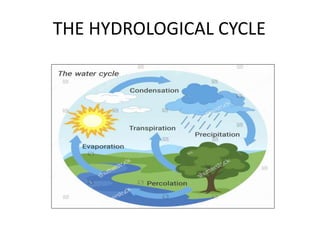
The hydrological cycle
- 2. LESSON OBJECTIVES At the end of the lesson topic, students should be able to: • Define the concepts: Hydrological/Water Cycle, evaporation, transpiration condensation, precipitation, runoff, percolation, groundwater. • Outline the main components of the Hydrological Cycle • Draw a simple diagram outlining the stages of the hydrological cycle.
- 3. What is the Hydrological Cycle? • The natural process through which water passes into the atmosphere as water vapour, precipitates to earth in liquid or solid form, and again returns to the atmosphere through evaporation, to continue.
- 4. The Hydrological Cycle Process • Most of the world’s water is stored in the oceans and seas. Water evaporates from the oceans and seas, and is held as water vapour in the atmosphere. Water from the atmosphere falls as rain or snow. When it reaches the ground, most of it flows into rivers and returns to the sea.
- 5. Main Processes in the Hydrological Cycle 1) Evaporation 2) Transpiration 3) Condensation 4) Precipitation 5) Surface Runoff 6) Infiltration 7) Percolation INSTRUCTION: Use the diagram to explain what happens in each of the processes above.
- 6. • Water is transferred from the sea and land to the atmosphere by evaporation and transpiration; then from the atmosphere to the land and sea by precipitation, falling as rain or snow. The water then infiltrates in the soil and percolates further into the ground to become part of the groundwater. It then travels from the land to the oceans by rivers, streams, in the process called surface runoff, and as groundwater seepage in a process called throughflow, where it then is evaporated into the atmosphere again.
- 7. DEFINITION OF PROCESES IN THE HYDROLOGICAL CYCLE • Evaporation: - the process by which heat from the Sun causes water on Earth (in oceans, lakes) to turn from liquid into gas (water vapor) and rise into the sky. • Transpiration: - the process by which plants lose water which is absorbed into the atmosphere. • Condensation: - the process by which water vapor in the clouds becomes water again due to cooling, and forms clouds. • Precipitation: - water that falls or returns from the sky in the form of rain, snow, hail, or sleet.
- 8. • Surface Run-off:- the flow of rainwater over the land surface. • Infiltration:- penetration of water into the soil or rocks. • Percolation:- the process by which water seeps or travels downwards into the soil through the tiny spaces between rocks and soil particles. • Groundwater:- water found beneath the land surface.
- 9. Let’s complete this diagram.
- 11. END
- 18. • A brief treatment of the water cycle follows. For full treatment, see hydrosphere: The water cycle. • Evaporation, one of the major processes in the cycle, is the transfer of water from the surface of the Earth to the atmosphere. By evaporation, water in the liquid state is transferred to the gaseous, or vapour, state. This transfer occurs when some molecules in a water mass have attained sufficient kinetic energy to eject themselves from the water surface. The main factors affecting evaporation are temperature, humidity, wind speed, and solar radiation. The direct measurement of evaporation, though desirable, is difficult and possible only at point locations. The principal source of water vapour is the oceans, but evaporation also occurs in soils, snow, and ice. Evaporation from snow and ice, the direct conversion from solid to vapour, is known as sublimation. Transpiration is the evaporation of water through minute pores, or stomata, in the leaves of plants. For practical purposes, transpiration and the evaporation from all water, soils, snow, ice, vegetation, and other surfaces are lumped together and called evapotranspiration, or total evaporation.
- 19. • Water vapour is the primary form of atmospheric moisture. Although its storage in the atmosphere is comparatively small, water vapour is extremely important in forming the moisture supply for dew, frost, fog, clouds, and precipitation. Practically all water vapour in the atmosphere is confined to the troposphere (the region below 6 to 8 miles [10 to 13 km] altitude). The transition process from the vapour state to the liquid state is called condensation. Condensation may take place as soon as the air contains more water vapour than it can receive from a free water surface through evaporation at the prevailing temperature. This condition occurs as the consequence of either cooling or the mixing of air masses of different temperatures. By condensation, water vapour in the atmosphere is released to form precipitation. • Precipitation that falls to the Earth is distributed in four main ways: some is returned to the atmosphere by evaporation, some may be intercepted by vegetation and then evaporated from the surface of leaves, some percolates into the soil by infiltration, and the remainder flows directly as surface runoff into the sea. Some of the infiltrated precipitation may later percolate into streams as groundwater runoff. Direct measurement of runoff is made by stream gauges and plotted against time on hydrographs. • Most groundwater is derived from precipitation that has percolated through the soil. Groundwater flow rates, compared with those of surface water, are very slow and variable, ranging from a few millimetres to a few metres a day. Groundwater movement is studied by tracer techniques and remote sensing. • Ice also plays a role in the water cycle. Ice and snow on the Earth’s surface occur in various forms such as frost, sea ice, and glacier ice. When soil moisture freezes, ice also occurs beneath the Earth’s surface, forming permafrost in tundra climates. About 18,000 years ago glaciers and ice caps covered approximately one-third of the Earth’s land surface. Today about 12 percent of the land surface remains covered by ice masses.